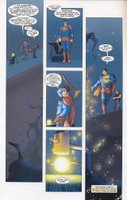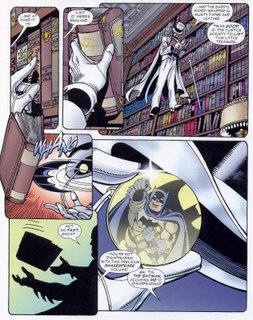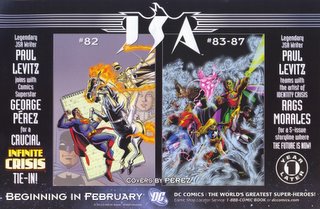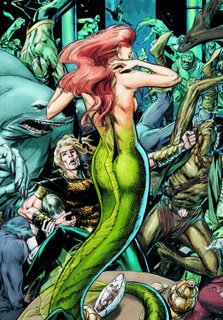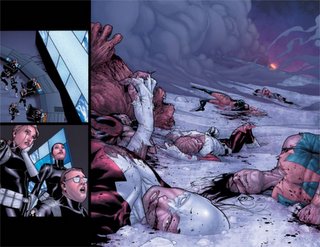- - - - - - - - - - - - - - - - - - - - - - - - - - - - - - - - - - - - - - - - - - - - - - - -
 In this issue:
In this issue:a review of Amazing Spider-Man #529 / notes on a We3 companion video by Vitalic that will delight you, Marvel's creative rebound, Quizilla: Marriage Edition / rants about artistic anticlimax
- - - - - - - - - - - - - - - - - - - - - - - - - - - - - - - - - - - - - - - - - - - - - - - -

reviews
Amazing Spider-Man #529 (Marvel)
J. Michael Straczynski (Writer) / Ron Garney (Penciller) / Bill Reinhold (Inker) / Matt Milla (Colorist) / VC's Cory Petit (Letterer)
 Okay, okay, we’ve all enjoyed a good giggle about the Lovecraftian Spider Penis, and even a good groan at the No-Prize inspired, fourth-wall busting, eyeball-rolling smirk on page 4. But at the end of the day, this issue of Amazing Spider-Man was a very pleasant surprise.
Okay, okay, we’ve all enjoyed a good giggle about the Lovecraftian Spider Penis, and even a good groan at the No-Prize inspired, fourth-wall busting, eyeball-rolling smirk on page 4. But at the end of the day, this issue of Amazing Spider-Man was a very pleasant surprise.  Y’see, I’m one of those. You know the ones. Those guys who are suckers for cheap marketing gimmicks like costume changes, provided the new duds are attractive. There’s just something about old wine in new bottles that I’m powerless to resist—a shocking confession on a nostalgia-drenched site like this one, I’m sure.
Y’see, I’m one of those. You know the ones. Those guys who are suckers for cheap marketing gimmicks like costume changes, provided the new duds are attractive. There’s just something about old wine in new bottles that I’m powerless to resist—a shocking confession on a nostalgia-drenched site like this one, I’m sure.Of course, if the wine has fermented, not even a snazzy new bottle is going to make me drink more than a sip. In the case of Amazing Spider-Man #529 and the (apparently much reviled) “Iron Spidey” suit, though, I quite happily finished the bottle and find myself feeling a little drunk. So drunk, in fact, that I’m thinking seriously about investing in a whole case. Maybe even buying into the winery again.
 The thing is, I haven’t read Spiderman regularly for years—literally not since Todd McFarlane was drawing Amazing back in the late 1980s. And this absence is despite the fact that Spider-Man is, conceptually, one of my favorite Marvel characters. Despite the fact, too, that I remember many stories from that era with great fondness: the delightfully interminable Hobgoblin mystery by Tom DeFalco and Ron Frenz, the “Gang War” story by Tom, Jim Owsley, and Alan Kupperberg, the “Missing in Action” crossover within the Spidey-titles, and of course the tour de force by J. M. DeMatteis, Mike Zeck, and Bob McLeod, “Kraven’s Last Hunt.” What ever happened to that Spidey? Every now and then, I pick up an issue of Amazing, just to see what’s new, and I’ve flirted with returning in a serious way several times before, usually whenever it looks like the new bottle is shiny enough and that it really does contain a hint of that old grape, some stash that was blessedly preserved in a connoisseur’s secret wine cellar when someone let the Spider Clones loose to trash the liquor store.
The thing is, I haven’t read Spiderman regularly for years—literally not since Todd McFarlane was drawing Amazing back in the late 1980s. And this absence is despite the fact that Spider-Man is, conceptually, one of my favorite Marvel characters. Despite the fact, too, that I remember many stories from that era with great fondness: the delightfully interminable Hobgoblin mystery by Tom DeFalco and Ron Frenz, the “Gang War” story by Tom, Jim Owsley, and Alan Kupperberg, the “Missing in Action” crossover within the Spidey-titles, and of course the tour de force by J. M. DeMatteis, Mike Zeck, and Bob McLeod, “Kraven’s Last Hunt.” What ever happened to that Spidey? Every now and then, I pick up an issue of Amazing, just to see what’s new, and I’ve flirted with returning in a serious way several times before, usually whenever it looks like the new bottle is shiny enough and that it really does contain a hint of that old grape, some stash that was blessedly preserved in a connoisseur’s secret wine cellar when someone let the Spider Clones loose to trash the liquor store. One issue isn’t enough to convince me, but Amazing Spider-Man #529 has a lot going for it, not the least of which is Ron Garney and Bill Reinhold’s fantastic visuals. Garney is, to me, the perfect Spidey-artist: his pencils are loose and dynamic, reminiscent of all the best Spidey artists since the 80s: Sal Buscema, Ron Frenz, and John Romita Jr. And I have to say it: I really dig the way he draws the new Spidey costume in this issue.
 There are, of course, lots and lots of things that seem “wrong” with the new costume, perhaps most of all its implicit heaviness. Spider-Man is supposed to be light on his feet, not weighed down by body armor. And he’s supposed to be vulnerable too—that’s precisely what makes him the quintessential Marvel character. That scene in which Peter (facetiously?) asks Tony for heat vision and rocket-boot enhancements is a tongue-in-cheek acknowledgement that the new suit makes Spidey absurdly powerful. Indeed, the new suit seems to rob Spidey of everything that makes him, well…Spidey! (And I must say, at least give him four golden Spidey-legs so that he has eight appendages in all—or are we actually supposed to count "eight" already, and Quesada really is having a Spider-penis joke on us after all??)
There are, of course, lots and lots of things that seem “wrong” with the new costume, perhaps most of all its implicit heaviness. Spider-Man is supposed to be light on his feet, not weighed down by body armor. And he’s supposed to be vulnerable too—that’s precisely what makes him the quintessential Marvel character. That scene in which Peter (facetiously?) asks Tony for heat vision and rocket-boot enhancements is a tongue-in-cheek acknowledgement that the new suit makes Spidey absurdly powerful. Indeed, the new suit seems to rob Spidey of everything that makes him, well…Spidey! (And I must say, at least give him four golden Spidey-legs so that he has eight appendages in all—or are we actually supposed to count "eight" already, and Quesada really is having a Spider-penis joke on us after all??)But here’s the thing that redeems the new Spidey costume for me. It isn’t just that it looks slick, but that it, and the new powers that accompany it, finally defamiliarize Spider-Man for us again, so that we can feel the danger that Peter feels when he leaps off that roof and must trust in the new suit’s ability to allow him to glide safely down to the street. The scene where Peter steps into space to the immortal words of “…here goes nothinnnnnngggggg!” is an obvious quotation of a similar scene in Sam Raimi’s first Spiderman film, where Peter first has to trust that his webbing will allow him to swing safely through the city. And it works: despite the seemingly invulnerable suit, we still get a little taste of vulnerability in that moment.
 The action sequences of this issue of Amazing are also designed, it seems, to quell our anxiety that the new suit fundamentally violates the most basic aspects of Spidey’s character. The cute quips as he lands on the roof of a speeding car and peels it open to confront the sleaze bags and the wonderful bit of business where he steers the car with his webs, while riding it like a surf board over the 59th Street Bridge while singing Simon and Garfunkel’s 59th Street Bridge Song (Feelin’ Groovy) (loved this!!). This song is at the core of the issue’s management of the potential problems created by the new costume—it’s a metaphor for all the lightness and “gooviness” that the more militaristic “Iron Spidey” costume risks undermining. The song is the perfect encapsulation of the joyfulness and the freedom from care that one associates with Spidey’s swings through the city. Here are the lyrics, and here is a brief audio clip (click the link on the right hand side of the screen) for anyone too young to not know this sublime ode to everyday happiness by heart. So yeah, when Spidey turns into Superman, deflecting a thug’s bullet off his back at the end of this issue, it still “feels” like Spider-Man, at least to me. For once, it feels like something’s gone right for old Spidey—he’s got cause for “feelin’ groovy,” and so do we.
The action sequences of this issue of Amazing are also designed, it seems, to quell our anxiety that the new suit fundamentally violates the most basic aspects of Spidey’s character. The cute quips as he lands on the roof of a speeding car and peels it open to confront the sleaze bags and the wonderful bit of business where he steers the car with his webs, while riding it like a surf board over the 59th Street Bridge while singing Simon and Garfunkel’s 59th Street Bridge Song (Feelin’ Groovy) (loved this!!). This song is at the core of the issue’s management of the potential problems created by the new costume—it’s a metaphor for all the lightness and “gooviness” that the more militaristic “Iron Spidey” costume risks undermining. The song is the perfect encapsulation of the joyfulness and the freedom from care that one associates with Spidey’s swings through the city. Here are the lyrics, and here is a brief audio clip (click the link on the right hand side of the screen) for anyone too young to not know this sublime ode to everyday happiness by heart. So yeah, when Spidey turns into Superman, deflecting a thug’s bullet off his back at the end of this issue, it still “feels” like Spider-Man, at least to me. For once, it feels like something’s gone right for old Spidey—he’s got cause for “feelin’ groovy,” and so do we.The other great thing about this issue—the thing that makes this feel like a real Spider-Man comic—is the way it combines a sense of fun with an equal sense of impending doom. I could be totally off-base here, but after much mental resistance and even a bit of trash-talking, I’m actually getting kind of interested in this whole Civil War business. I don’t really have much of an opinion about whether or not the new Peter Parker/Tony Stark relationship makes sense—I’ve never read an issue of Iron Man in my life, but I am so far enjoying the new situation, and Straczynski’s comment that Peter is a guy who might have a weakness for father-figures rings true. The exciting thing about the “blood oath” that is given at the end of this issue is that it promises to embroil Spider-Man in a conflict with some real stakes. I’m hopeful that it will generate the kind of turmoil and anguish in the Spider-books that give meaning to those precious moments when Spidey and the reader genuinely are feelin’ groovy.

notes
We3: The Companion Video by Vitalic
 Attention: fans of the Morrison/Quitely animal story masterpiece. Have you seen this? Just…wow. It takes a minute to load, but it’s worth it. Courtesy of the unbelievably awesome Cliptip.
Attention: fans of the Morrison/Quitely animal story masterpiece. Have you seen this? Just…wow. It takes a minute to load, but it’s worth it. Courtesy of the unbelievably awesome Cliptip.A Marvel Renaissance?
Building on last week’s gushing about Quesada's Alpha Flight and Moon Knight news, my excitement about some of Marvel’s upcoming events continues to grow:
These tidbits from the Marvel Mondo panel at the New York Comic Con sound very interesting:
Brian K. Vaughan is writing a new Doctor Strange limited series with art by Marcos Martin, featuring a slightly tweaked version of the costume. (Despite what I said about Spidey’s new duds, I could do without the costume tweak on Strange—his costume is already magnificent. Still, Marcos Martin is a huge talent and Vaughn on Strange sounds like a great pairing.)
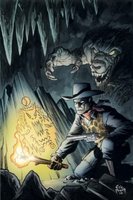 And this sounds absolutely incredible: Two Gun Kid by Dan Slott and Eduardo Barretto. The main story will run 22 pages, and will feature a six page backup by Keith Giffen and Mike Allred starring Hugo, the midget cowboy who appeared in an early issue of Two Gun Kid. (Slott, Giffen, and Allred will no doubt do bang-up jobs, but the real excitement for me is seeing Eduardo Barretto’s work again. I had a hard time adjusting to the transition from Perez to Barretto back when the latter took over art chores on The New Teen Titans, but grew to love his work. A western is a perfect fit—should be classic.) In a similar vein, this also sounds promising: Strange Western Starring Black Rider by Steve Englehart and Marshall Rogers, with an 8-page backup by Joe Lansdale art by Spanish artist Rafa Garres. Cool!
And this sounds absolutely incredible: Two Gun Kid by Dan Slott and Eduardo Barretto. The main story will run 22 pages, and will feature a six page backup by Keith Giffen and Mike Allred starring Hugo, the midget cowboy who appeared in an early issue of Two Gun Kid. (Slott, Giffen, and Allred will no doubt do bang-up jobs, but the real excitement for me is seeing Eduardo Barretto’s work again. I had a hard time adjusting to the transition from Perez to Barretto back when the latter took over art chores on The New Teen Titans, but grew to love his work. A western is a perfect fit—should be classic.) In a similar vein, this also sounds promising: Strange Western Starring Black Rider by Steve Englehart and Marshall Rogers, with an 8-page backup by Joe Lansdale art by Spanish artist Rafa Garres. Cool!And check out this insanity:
 Quesada went on to announce John Romita Jr. will be the artist of Neil Gaiman’s upcoming Eternals limited series, launching in June ’06.
Quesada went on to announce John Romita Jr. will be the artist of Neil Gaiman’s upcoming Eternals limited series, launching in June ’06. Romita said when drawing Eternals, he plasters his office with Jack Kirby art, and lets loose. Quesada said the Gaiman project will work to tie the Eternals into the fabric of the Marvel Universe. “By the time we’re done, Jack’s creation will be a fertile part of the Marvel Universe. The Eternals will be that ‘other race’ that we need, alongside humans and mutants.” Gaiman will also be setting things up for more Eternals stories afterwards.
I loved Kirby’s Eternals and John Romita Jr. is an outstanding choice for artist. I cannot wait for this, especially having seen some of Romita Jr.’s preliminary sketches. Drool.
 Oh, and speaking of cosmic, I seem to be working myself into a bit of a froth about Annihilation by Keith Giffen, Scott Kollins, and Ariel Olivetti. (Thanks to Filipe for reminding me about Giffen’s involvement in this in the comments section to SA 2.3.) This recent Q&A at CBR with Keith Giffen and editor Andy Schmidt should be enough to whet any cosmic Marvel fan’s appetite. Here’s a preview of Kolins’s pretty pictures too.
Oh, and speaking of cosmic, I seem to be working myself into a bit of a froth about Annihilation by Keith Giffen, Scott Kollins, and Ariel Olivetti. (Thanks to Filipe for reminding me about Giffen’s involvement in this in the comments section to SA 2.3.) This recent Q&A at CBR with Keith Giffen and editor Andy Schmidt should be enough to whet any cosmic Marvel fan’s appetite. Here’s a preview of Kolins’s pretty pictures too.Finally (and I know this image is old news), there's something kind of thrilling about this intensely nostalgic cover:
 I've had a hard time caring about the X-Men since Morrison left (even Whedon's Astonishing has left me kind of lukewarm); maybe Brubaker and Tan will be the ones to change that. And if not, at least I can drool over Simone Bianchi's lastest masterworks:
I've had a hard time caring about the X-Men since Morrison left (even Whedon's Astonishing has left me kind of lukewarm); maybe Brubaker and Tan will be the ones to change that. And if not, at least I can drool over Simone Bianchi's lastest masterworks:
 Is it just me, or do these feel like syntheses of Bill Sienkiewicz and Barry Windsor-Smith circa 1984? More please!
Is it just me, or do these feel like syntheses of Bill Sienkiewicz and Barry Windsor-Smith circa 1984? More please!Which Superhero Are You? Marriage Edition
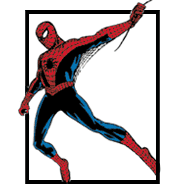 Neurotic? Anxious? Married to an amazing woman who is too good for me? Really, could there have been any other result?
Neurotic? Anxious? Married to an amazing woman who is too good for me? Really, could there have been any other result?Your results: You are Spider-Man
You are intelligent, witty, a bit geeky and have great power and responsibility.
Click here to take the Superhero Personality Test
 My wife is never one to resist a quiz (or my transparent attempts at flattery), so when she saw this, she too wanted to play.
My wife is never one to resist a quiz (or my transparent attempts at flattery), so when she saw this, she too wanted to play.Her results: You are Superman
You are mild-mannered, good, strong and you love to help others.
Click here to take the "Which Superhero am I?" quiz...
 I'll never look at an image like this quite the same way again!
I'll never look at an image like this quite the same way again!
rants
Not With a Bang But a Whimper
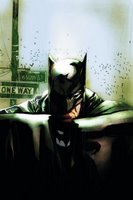 Have I mentioned how much I hate it when really strong multi-part storylines end up having their climactic chapters illustrated by guest-pencillers? This seems particularly to happen during the final issues of long-running series that are either being cancelled or that are about to be rebooted with much fanfare.
Have I mentioned how much I hate it when really strong multi-part storylines end up having their climactic chapters illustrated by guest-pencillers? This seems particularly to happen during the final issues of long-running series that are either being cancelled or that are about to be rebooted with much fanfare.There are too many examples to count, of course, but the most egregious of these for me was the shameful wrap-up of the second Outsiders series back in the early 90s when Erik Larsen was brought in to complete the awful, awful Millennium crossover that brought that book to its excruciating conclusion by revealing Dr. Jace as a traitor, “killing” Metamorpho, and disbanding the team. It was a crummy way to end things, made even worse by the incredibly jarring shift in artistic styles from Aparo to Larsen. (This is a rather idiosyncratic example, I know. I’m sure you can think of better ones.)
 I’ve been particularly irritated about this with regard to the (semi-)wrap up of the Jason Todd storyline in Batman. This story represents some of Winick’s best DC work; it is an important story in its own right; and it seems to be significant, too, with regard to setting up the OYL DCU. It should have been Doug Mahnke all the way. And if it couldn’t be (he’s doing such nice work over on Morrison’s Frankenstein that I can hardly complain too bitterly about losing him on this title), then DC should, at the very least, have found someone who drew in a similar style to complete the storyline in Batman—particularly given that it will all be collected as a trade. I have nothing against Eric Battle and Rodney Ramos, but come on! The story may end with an explosion, but I’m feeling a little…I dunno. Pfft.
I’ve been particularly irritated about this with regard to the (semi-)wrap up of the Jason Todd storyline in Batman. This story represents some of Winick’s best DC work; it is an important story in its own right; and it seems to be significant, too, with regard to setting up the OYL DCU. It should have been Doug Mahnke all the way. And if it couldn’t be (he’s doing such nice work over on Morrison’s Frankenstein that I can hardly complain too bitterly about losing him on this title), then DC should, at the very least, have found someone who drew in a similar style to complete the storyline in Batman—particularly given that it will all be collected as a trade. I have nothing against Eric Battle and Rodney Ramos, but come on! The story may end with an explosion, but I’m feeling a little…I dunno. Pfft.Please feel free to vent your own “not with a bang but a whimper” gripes below.

